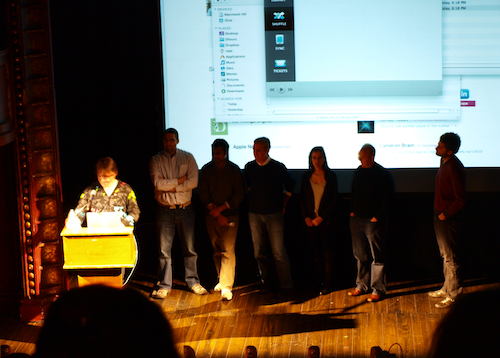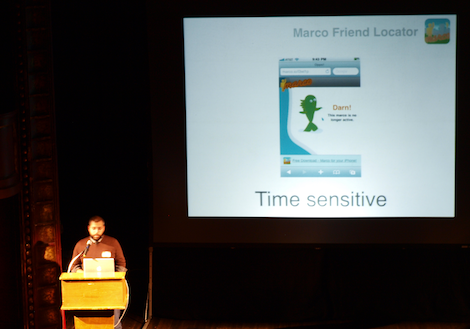It’s the most wonderful time of the year. And there is no other place I’d rather be than New York City in December— chestnuts roasting, falafels cooking, and Food52 giving a demo at New York Tech Meetup.
Of course, this is also the season of NJ Transit delays, so thanks to mechanical problems at Sunnyside Yards yesterday, I missed most of 52’s presentation. As I walked into NYTM’s temporary digs at New World Stages on 50th street, I heard some questions being asked about “FoodPickle.” FoodPickle? More on that later.
My favorites from the evening: WanderFly, Food52, and Marco. In the interesting, but problematic category: ClearGears.
I liked the smaller and more intimate space of New World Stages, home to Gazillion Bubble Show, Avenue Q, and Freckleface Strawberry: The Musical. Sure I’ve been drawing unfavorable comparisons between brassy, brawling NYTM and home-spun, folksy HTM. But last night, NYTM had the best of both worlds: big demos in a cozy venue. It felt more like a town hall meeting—in fact, attendees heard candidates for NYTM board positions—albeit the town is somewhere in Technistan.
Food52
I first heard about Food52 from my wife, who is the real chef in the family—I’m a sous-chef in training. What makes Food52 different from the standard fare foodie site is that its dedicated community of do-it-yourself home cooks submit recipes, which are reviewed by Amanda Hesser (The New York Times food writer aka Ms. Latte) with her partner Merrill Stubbs.

Food52, Xydo, and Instinctiv on stage with Nate.
The recipes are tested by editors, the community members receive recognition (through weekly contests) and non-virtual awards (Food 52 is compiling a book of best recipes), and the photos almost resemble the finished product without the use of excessive photo trickery.
FoodPickle, by the way, is the crowdsourced question-and-answer part of the web site, where you get recommendations and advice from the Food52 community. If you’re in a “pickle” about whether to use your ricer to make tomato soup, the 52 cooks will have the answer.
WanderFly
The slickest interface I’ve seen in a very long time was shown off by the team from WanderFly, the “travel inspiration” startup. Instead of first deciding on a destination and itinerary and then doing all the painstaking research, WanderFly lets you pick an experience (food, culture, outdoors, beach, etc.) and overall destination (Europe, Asia), and its back-end then decides on country, cities, restaurants, hotels, and tours that will achieve the targeted result.
You should at once register with WanderFly just to experience the spinning tiles that eventually settle down to show the actual travel ideas. Obviously, this is not the TripAdvisor model, and it is unfair to make comparisons.
Good question from the audience: where’s the travel content (text and pics) coming from? Answer: the likes of Lonely Planet, Yelp, Find. Eat. Drink., and others.
And this led to a solid follow-up question in the cross-examination from NYTMers: how do you decide what to present as suggestions? According to co-founder Christy Liu, “content managers research all the different destinations and all the trip themes.”
Interesting. Like Food52 the raw content is edited and reviewed by human editors. I am subtly pointing out that judgment and discernment by those with knowledge and experience is a key ingredient IMO in successful recommendation sites.
The formula seems to work. I performed a quick test to see what WanderFly would suggest for Rome, with “food” and “culture” experience parameters checked. As a recently returned traveler there, I will confirm that Il Matriciano is a great choice: their alice fritti and carciofi fritti were memorable.
FYI: WanderFly will be increasing the number of travel destinations (currently set at 1200) in the coming weeks, adding new feeds, and adding new experiences, including the much asked for “Geeks on a Plane.”
Marco
From the impressive NYC-based design studio Uncommon Projects comes Marco, a free iPhone app that provides precise geo locations for urban rendezvouses. It is a well thought out idea that honors privacy through two-phase opt-in and temporary storage of transaction information.

Marco’s Tarikh Korula with officially approved PowerPont.
One of its novel features is that only one party needs an iPhone. How is this possible? Because generic SMS is used to transfer a link, that’s how.
Once the callee accepts (opt-in phase 1), they can then decide whether to share (opt-in step 2) their location. Obviously, a smartphone with a capable browser is the minimal requirements for interacting in Marco. And since GPS coordinates can be off, Marco also improves location granularity by letting users nudge their position on the shared map. Nice touch.
ClearGears
When I first heard the words “employee review system”, “on-going”, and “real-time” in ClearGears’ overview statement, I was slightly suspicious. Mostly this has to with my time spent reviewing and writing marketing copy (don’t ask) on call center software.
But first, let me applaud ClearGears for trying to improve the review process in mid- and large-size companies by surveying team members on a regular basis. In their model, survey questions are emailed daily to measure a co-worker’s performance or some other strategic metric. Management and the team now have a longer view of performance (in graphical format), which is far better than the what-have-you-done-lately philosophy that is the norm.
Unfortunately, a real-time view of employee results is often also seen in, um, call centers, where agents are continually monitored and appropriately rewarded or punished. In the right hands, ClearGears can be useful. In the wrong hands, you may soon find yourself having as much job satisfaction as a telemarketer.
ClearGears guys: if you ever partner with a company that makes LED leaderboards (the kind found in call centers), I will be quite upset.
And NYTM Board Candidates
I enjoyed listening to the candidates for NYTM board membership. All would add unique values and insights, but here are the ones I thought stood out: Brandon Diamond, Evan Korth, Sanford Dickert, and Tony Bacigalupo.
Happy Holidays!


